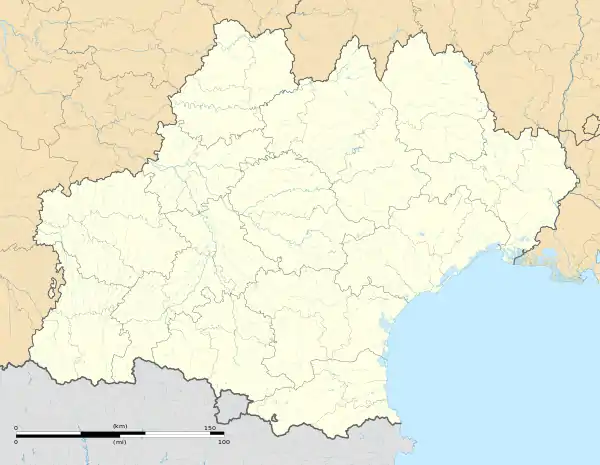Bretenoux | |
|---|---|
Location of Bretenoux | |
 Bretenoux  Bretenoux | |
| Coordinates: 44°54′54″N 1°50′21″E / 44.915°N 1.8392°E | |
| Country | France |
| Region | Occitania |
| Department | Lot |
| Arrondissement | Figeac |
| Canton | Cère et Ségala |
| Government | |
| • Mayor (2020–2026) | Pierre Moles[1] |
| Area 1 | 5.69 km2 (2.20 sq mi) |
| Population | 1,389 |
| • Density | 240/km2 (630/sq mi) |
| Time zone | UTC+01:00 (CET) |
| • Summer (DST) | UTC+02:00 (CEST) |
| INSEE/Postal code | 46038 /46130 |
| Elevation | 129–245 m (423–804 ft) (avg. 136 m or 446 ft) |
| 1 French Land Register data, which excludes lakes, ponds, glaciers > 1 km2 (0.386 sq mi or 247 acres) and river estuaries. | |
Bretenoux (French pronunciation: [bʁətnu]; Occitan: Bertenor) is a commune in the Lot department in southwestern France. The old town, a bastide, is an old medieval town designed with a grid street design with houses dating from 13th to the 16th Century's.
Toponymy
Bretenoux comes from the name Brittanorum villa, which means "the domain, the property, of the Breton villa."[3] The origin of the name may come from the settling of Breton in the area in 5 and 6th Century's AD after they fled their land from Angles and Saxons invaders.[3] Later names used was Villafranca d'Orilenda, Orlanda and Orlinda.[4]
History
The town is first mentioned in the monastery of Beaulieu's cartulary in 866.[5] It was called the Villa Bretenoro.[5]
Founded in 1277 by the powerful Guerin, Lord of Castelnau, it has retained its checker-board grid plan, squares and its covered arcades, remains of ramparts, and two beautiful turreted houses, one the town hall, the other the gendarmerie.[5][6]: 307 He granted the town fishing rights, access to the river islands, and two markets a year on condition a wall was constructed around the town with moats and four gates.[5]
Geography
Location
The Bastide is located north of the Lot, near the border with the Corrèze department, in the Dordogne Valley, Bretenoux is attached to the town of Biars-sur-Cère. It is watered by the Cère and Le Mamoul rivers, and crossed by the D940 and D803 national roads.
Demographics
| Year | Pop. | ±% p.a. |
|---|---|---|
| 1968 | 1,071 | — |
| 1975 | 1,115 | +0.58% |
| 1982 | 1,213 | +1.21% |
| 1990 | 1,211 | −0.02% |
| 1999 | 1,231 | +0.18% |
| 2009 | 1,342 | +0.87% |
| 2014 | 1,395 | +0.78% |
| 2020 | 1,370 | −0.30% |
| Source: INSEE[7] | ||
Local culture and heritage
Places and monuments
.jpg.webp)
- L'église Sainte-Catherine - built outside the walls in during 1600s and the outside remodelled in 1763;[5]
- La place des Consuls: Square in shape, surrounded by houses with arcades and half-timbered houses.
- The house of de l'oncle du Midi, Pierre Loti, on the corner of rue d'Orlinde and rue Pierre-Loti.
- The town hall (mairie) occupies the eastern facade of the old house of the Consuls.
- Château de Castelnau-Bretenoux is located on the neighbouring town of Prudhomat.
Notable persons
- Pierre François de Saint-Priest (1801-1851) is a French politician, born in Bretenoux;
- Louis Auguste Blanqui (1805-1881), a revolutionary, was arrested on March 17, 1871 in Bretenoux while ill, he was resting at a doctor friend's house;
- Adolphe de Lescure (1833-1892), historian and writer, attached to the secretariat of the Ministry of State (1865-1868) and head of the secretaries-writers of the Senate (1875-1892), was born in Bretenoux;
- Pierre Loti (1850-1923), a writer, spent part of his childhood at Bretenoux. He stayed there with his uncle, Pierre Bon, during the summer school holidays from 1861 to 1864. He kept some unforgettable memories that he describes in his latest books as: Le Roman d'un enfant, Prime jeunesse ou Journal intime;[5]
- Eugene Sol (1877-1953), Canon historian of the Lot, died at Bretenoux;
- David Moncoutié (1975-), professional cyclist, lived there.
International relations
Bretenoux is twinned with Glastonbury, United Kingdom.[8]
See also
References
- ↑ "Répertoire national des élus: les maires" (in French). data.gouv.fr, Plateforme ouverte des données publiques françaises. 13 September 2022.
- ↑ "Populations légales 2021". The National Institute of Statistics and Economic Studies. 28 December 2023.
- 1 2 Bazalgues, Gaston (2002). À la découverte des noms de lieux du Quercy. Toponymie lotoise (in French). Gourdon: Éditions de la Bouriane et du Quercy. p. 127. ISBN 2-910540-16-2.
- ↑ Crochet, Bernard (2012). Les plus belles bastides du Sud-Ouest (in French). Internet Archive. Rennes : Ouest-France. p. 78. ISBN 978-2-7373-5222-5.
- 1 2 3 4 5 6 Chantraine, Colette (17 September 1996). The Lot. Internet Archive. Le Editions du Laquet. p. 25. ISBN 978-2-910333-01-0.
- ↑ The Green Guide: Dordogne Berry Limousin. Michelin Travel Publication. 2002. ISBN 2060008719.
- ↑ Population en historique depuis 1968, INSEE
- ↑ "British towns twinned with French towns [via WaybackMachine.com]". Archant Community Media Ltd. Archived from the original on 5 July 2013. Retrieved 20 July 2013.